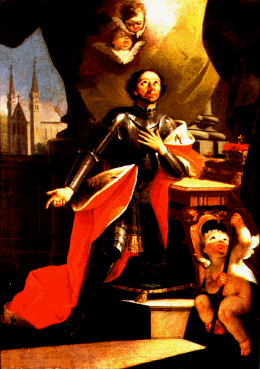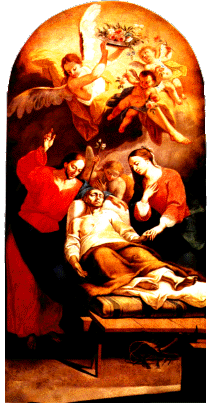
Anton Cebej
Archive reports about Cebej are extremely modest. Even those listed so far do not help us to get to know the painter’s life, but rather leave us in an even denser darkness. Only his paintings remain tangible signposts leading us through his life and work ...
Anton Cebej was born at Sturje in the parish of St George in the Vipava region, a place that is today a constituent part of the town of Ajdovscina ...
... How Cebej spent his youth and how he was to become an independent painter is not known. Likewise, we can only guess as to when he embarked on an independent career, for the first work that can with certainty be considered his own is the Exaltation of the Cross from Vinica, painted in 1750, when he was already twenty-eight years old. This painting proves that Cebej was trained in a solid, probably Slovene workshop and that at least in 1750 he carried out commissions independently ...
![]()

|
Left - A. Cebej: St Leopold oil on canvas, 109 x 77 cm (1960-65) .. During the first years of the seventh decade a few more unsignet paintings of high quality ware made, which have, ever since the first publications, been considered as characteristic Cebey’s works. These especially include three paintings in the National Gallery, Ljubljana: the banner Corpus Cristi - Sanguis Christi (presentation 133x103 mm), and the complementary paintings St Leopold and St Florian. They are characterized by formal and colour subtlety, typical of the Rococo mood, which is detectable in Cebej’s paintings already at the beginning of the sixties. |
|
oil on canvas, 198 x111 cm (1774), Ajdovscina . . . The Impact of Venice on Slovene painting has so far been emphasized in literatura more than once, and France Stele wrote in 1944 that the work of . . . painters from Ljubljana can be fully explained without taking into account the influence of Venetian painting. The shadow of Venice characteristically hovers over the painting of the Ljubljana Baroque in the largest sense of the word. However, despite the strong influence of Venetian painting on Cebej’s works, he remains a Central European painter . . . Just as archive reports are silent about the painter’s life, they are silent about his death: we know neither the time nor the place of it. The last dated paintings are from 1774 and the fact is that Cebej’s works from his last years are not geographically concentrated; one can find them in different parts of Kranjska and in the neighbouring Croatia. The only mutual centre of these locations is Ljubljana. In 1774 Cebej was fity-two years old and judging by the works from this period he was still full of creative power. His life and work can thus be summed up by assuming that he spent his last years in Ljubljana, but died probably somewhere on the way, perhaps outside his native contry, Kranjska.
From "Baroque Painter Anton Cebej"
|

|